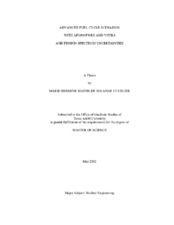| dc.contributor.advisor | Tsvetkov, Pavel V. | |
| dc.creator | Cuvelier, Marie-Hermine | |
| dc.date.accessioned | 2012-07-16T15:58:15Z | |
| dc.date.accessioned | 2012-07-16T20:24:05Z | |
| dc.date.available | 2014-09-16T07:28:19Z | |
| dc.date.created | 2012-05 | |
| dc.date.issued | 2012-07-16 | |
| dc.date.submitted | May 2012 | |
| dc.identifier.uri | https://hdl.handle.net/1969.1/ETD-TAMU-2012-05-10984 | |
| dc.description.abstract | Minimization of HLW inventories and U consumption are key elements guaranteeing nuclear energy expansion. The integration of complex nuclear systems into a viable cycle yet constitutes a challenging multi-parametric optimization problem. The reactors and fuel cycle performance parameters may be strongly dependent on minor variations in the system's input data. Proven discrepancies in nuclear data evaluations could affect the validity of the system optimization metrics.
This study first analyzes various advanced AP1000-VHTR fuel cycle scenarios by assessing their TRU destruction and their U consumption minimization capabilities, and by computing reactor performance parameters such as the time evolution of the effective multiplication factor keff, the reactors' energy spectrum or the isotopic composition/activity at EOL. The performance metrics dependence to prompt neutron fission spectrum discrepancies is then quantified to assess the viability of one strategy. Fission spectrum evaluations are indeed intensively used in reactors' calculations. Discrepancies higher than 10% have been computed among nuclear data libraries for energies above 8MeV for 235U.
TRU arising from a 3wt% 235U-enriched UO2-fueled AP1000 were incinerated in a VHTR. Fuels consisting of 20%, 40% and 100% of TRU completed by UO2 were examined. MCNPX results indicate that up to 88.9% of the TRU initially present in a VHTR fueled with 20% of TRU and 80% of ThO2 were transmuted. Additionally, the use of WgPu instead of RgPu should reduce the daily consumption of 235U by 1.3 and augment core lifetime.
To estimate the system metrics dependence to fission spectrum discrepancies and validate optimization studies outputs, the VTHR 235U fission spectrum distribution was altered successively in three manners. keff is at worst lowered by 1.7% of the reference value and the energy spectrum by 5% between 50meV and 2MeV when a significantly distorted fission spectrum tail is used. 233U, 236Pu and 237Pu inventories and activities are multiplied by 263, 523 and 34 but are still negligible compared to 239Pu mass or the total activity.
The AP1000-VHTR system is in conclusion not dependent on the selected fission spectrum variations. TRU elimination optimization studies in AP1000-VHTR systems will be facilitated by freeing performance metrics dependency from 1 input parameter. | en |
| dc.format.mimetype | application/pdf | |
| dc.language.iso | en_US | |
| dc.subject | TRU transmutation | en |
| dc.subject | TRU elimination | en |
| dc.subject | fission spectrum discrepancies | en |
| dc.subject | fission spectrum uncertainties impact on fuel cycle parameters | en |
| dc.subject | AP1000-VHTR fuel cycle | en |
| dc.subject | Thorium | en |
| dc.subject | ThO2 | en |
| dc.title | Advanced Fuel Cycle Scenarios with AP1000 PWRs and VHTRs and Fission Spectrum Uncertainties | en |
| dc.type | Thesis | en |
| thesis.degree.department | Nuclear Engineering | en |
| thesis.degree.discipline | Nuclear Engineering | en |
| thesis.degree.grantor | Texas A&M University | en |
| thesis.degree.name | Master of Science | en |
| thesis.degree.level | Masters | en |
| dc.contributor.committeeMember | McDeavitt, Sean M. | |
| dc.contributor.committeeMember | Ehlig-Economides, Christine | |
| dc.type.genre | thesis | en |
| dc.type.material | text | en |
| local.embargo.terms | 2014-07-16 | |


